Abstract
Pyocyanine, a pigment produced by Pseudomonas aeruginosa, has dual dose-dependent stimulatory as well as inhibitory effects on immune responses in vitro as measured by DNA synthesis of human T and B lymphocytes, interleukin-2 (IL-2) production by human T lymphocytes, immunoglobulin production by human B lymphocytes, and monokine production by human monocytes. In general, stimulatory activity was found at low concentrations of pyocyanine, whereas high concentrations of the pigment resulted in an inhibition of responses. At a pyocyanine concentration of 0.1 micrograms/ml or less the proliferation of T and B lymphocytes was enhanced, but at 0.5 micrograms/ml it was suppressed. IL-2 production by T lymphocytes was enhanced at concentrations up to 0.5 micrograms/ml but totally inhibited at 1.0 micrograms/ml. The differentiation of B lymphocytes to become immunoglobulin-producing cells was also enhanced in the presence of low doses of pyocyanine, whereas secretion of immunoglobulin by B lymphocytes was suppressed at all concentrations of pyocyanine. In contrast to the dual effects of pyocyanine on lymphocyte response, lipopolysaccharide-induced IL-1 and tumor necrosis factor release by monocytes was markedly enhanced by low as well as high concentrations of pyocyanine. From these results we conclude that this property of pyocyanine may lead to suppression of specific defense mechanisms and enhance harmful inflammatory reactions of the host during infection with Pseudomonas aeruginosa.
Full text
PDF
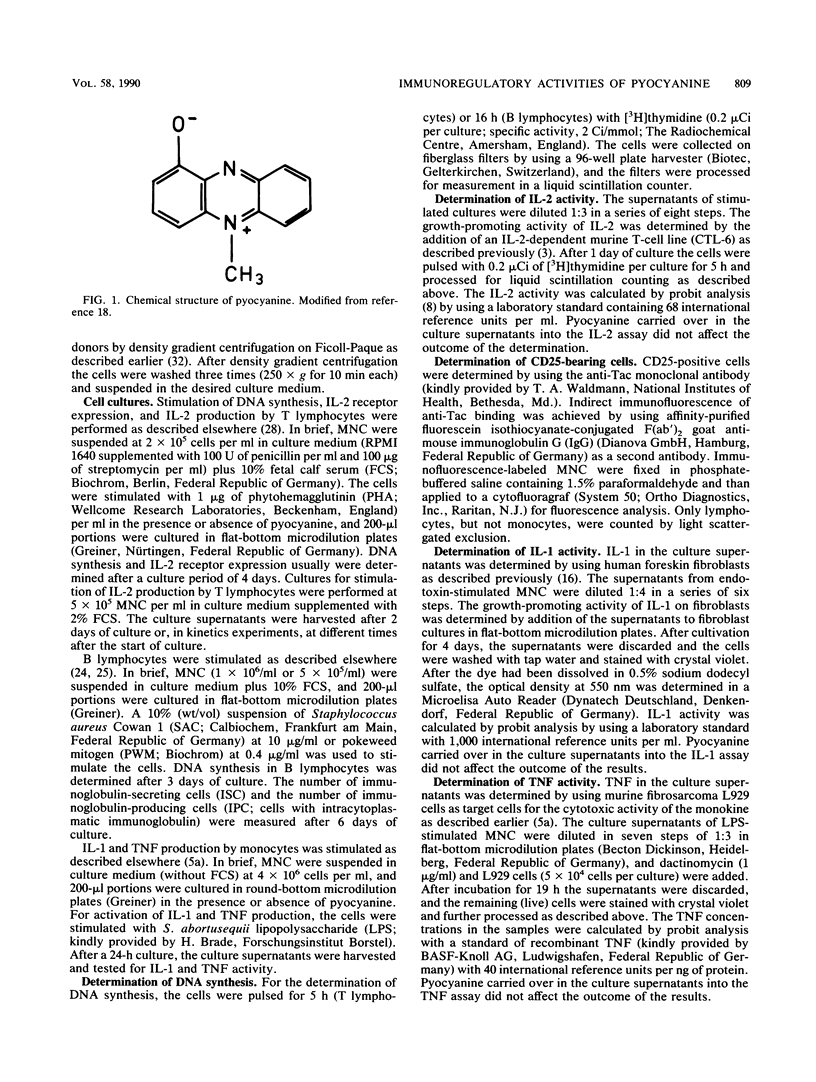
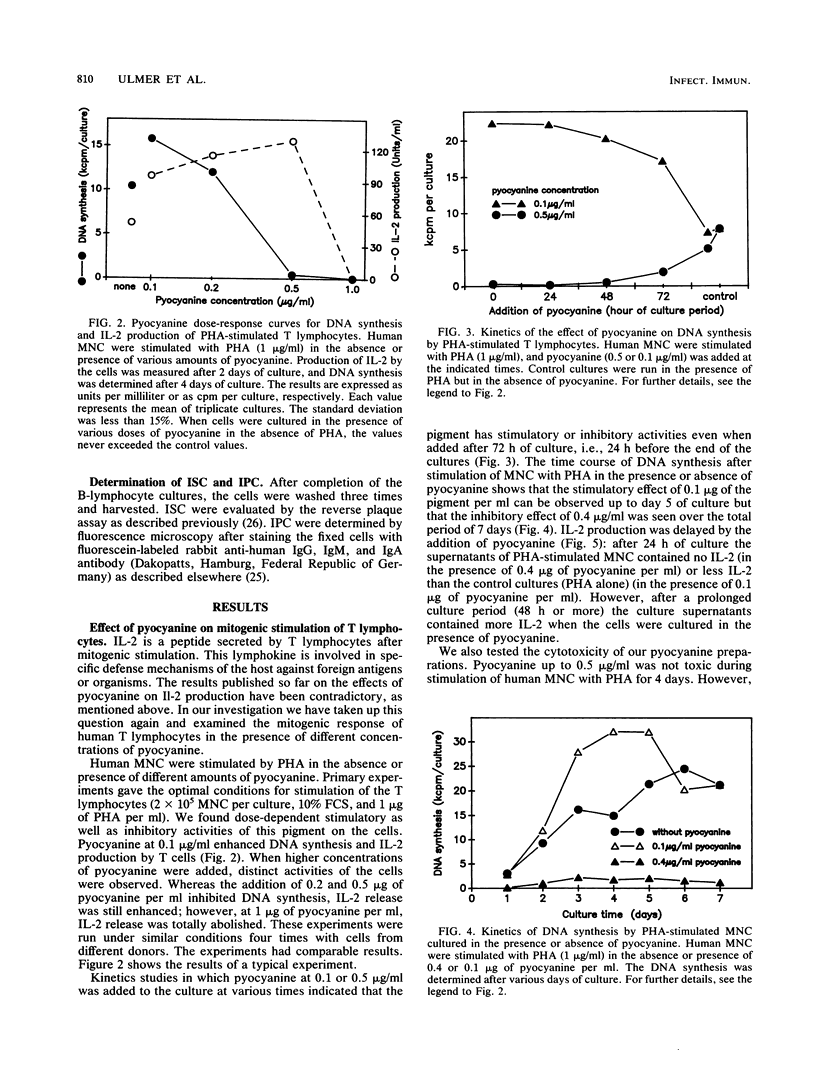


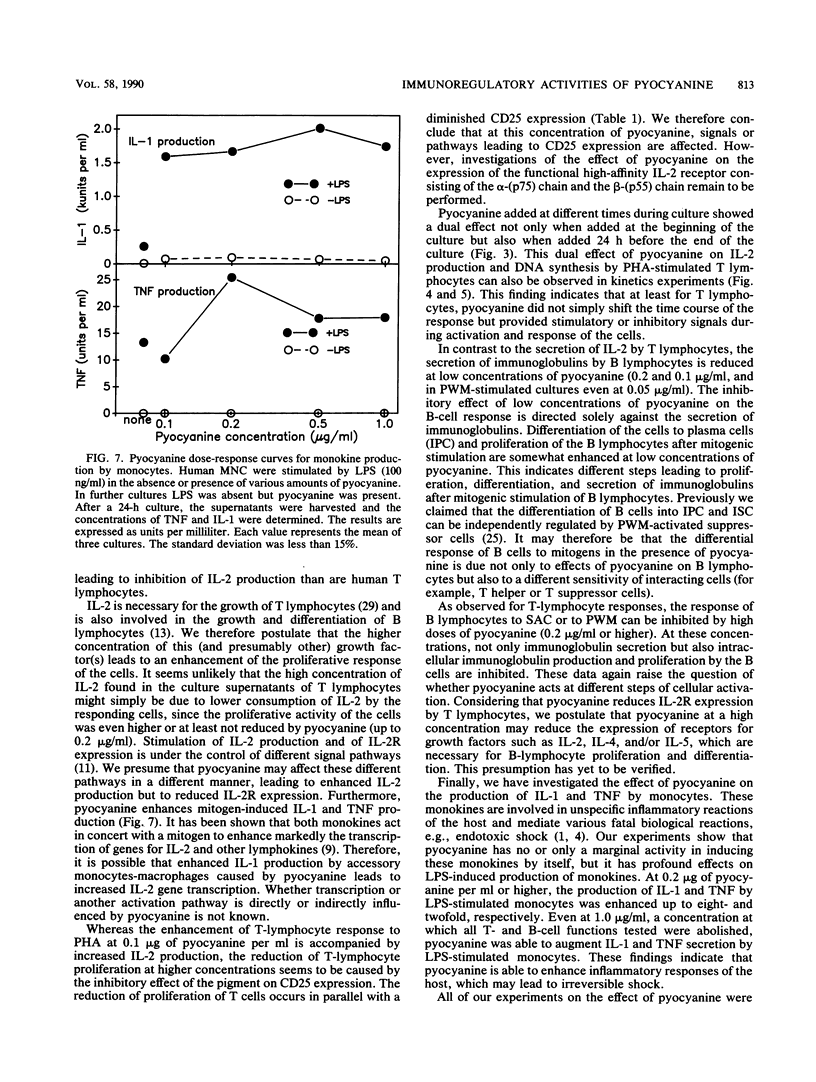
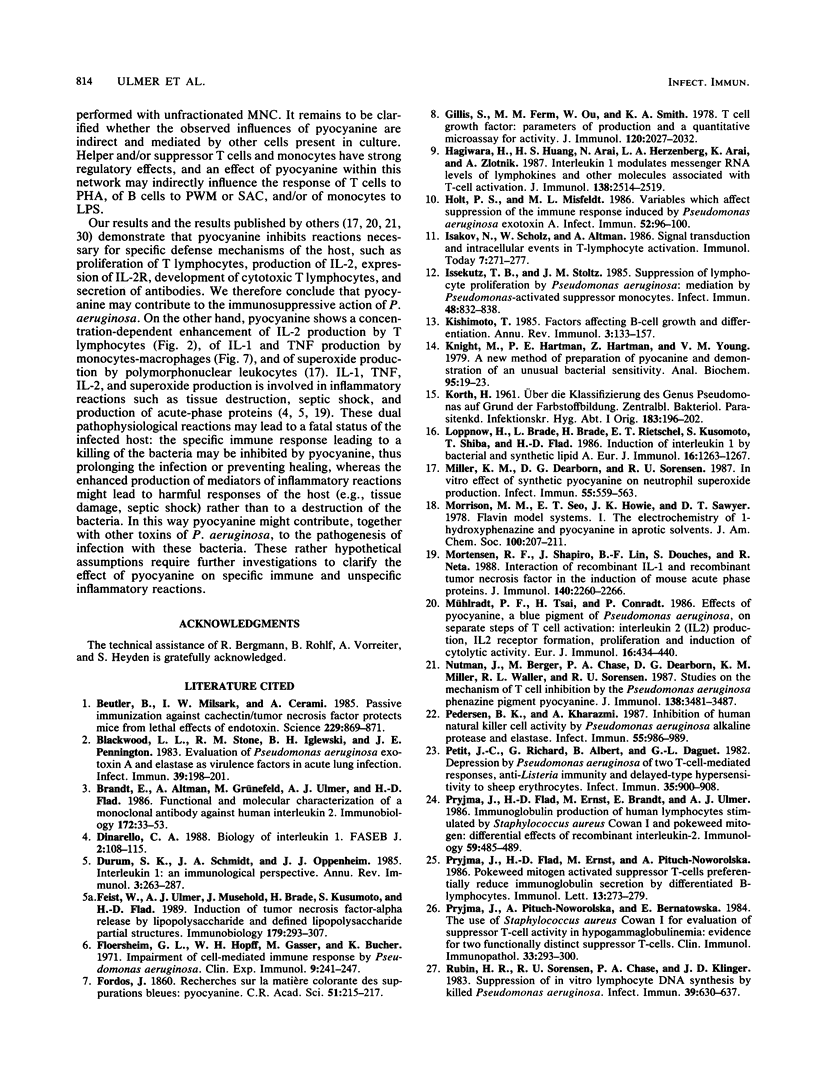
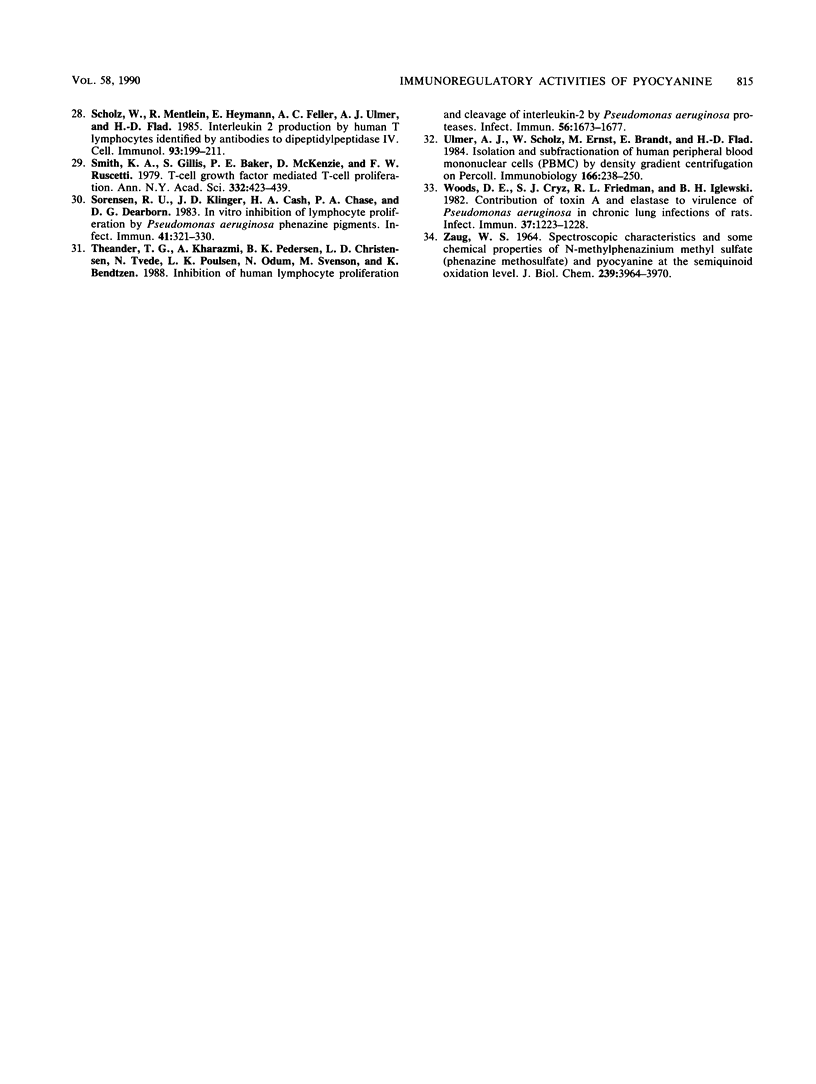
Selected References
These references are in PubMed. This may not be the complete list of references from this article.
- Beutler B., Milsark I. W., Cerami A. C. Passive immunization against cachectin/tumor necrosis factor protects mice from lethal effect of endotoxin. Science. 1985 Aug 30;229(4716):869–871. doi: 10.1126/science.3895437. [DOI] [PubMed] [Google Scholar]
- Blackwood L. L., Stone R. M., Iglewski B. H., Pennington J. E. Evaluation of Pseudomonas aeruginosa exotoxin A and elastase as virulence factors in acute lung infection. Infect Immun. 1983 Jan;39(1):198–201. doi: 10.1128/iai.39.1.198-201.1983. [DOI] [PMC free article] [PubMed] [Google Scholar]
- Brandt E., Altman A., Grünefeld M., Ulmer A. J., Flad H. D. Functional and molecular characterization of a monoclonal antibody against human interleukin 2. Immunobiology. 1986 Aug;172(1-2):33–53. doi: 10.1016/S0171-2985(86)80051-1. [DOI] [PubMed] [Google Scholar]
- Dinarello C. A. Biology of interleukin 1. FASEB J. 1988 Feb;2(2):108–115. [PubMed] [Google Scholar]
- Durum S. K., Schmidt J. A., Oppenheim J. J. Interleukin 1: an immunological perspective. Annu Rev Immunol. 1985;3:263–287. doi: 10.1146/annurev.iy.03.040185.001403. [DOI] [PubMed] [Google Scholar]
- Feist W., Ulmer A. J., Musehold J., Brade H., Kusumoto S., Flad H. D. Induction of tumor necrosis factor-alpha release by lipopolysaccharide and defined lipopolysaccharide partial structures. Immunobiology. 1989 Oct;179(4-5):293–307. doi: 10.1016/S0171-2985(89)80036-1. [DOI] [PubMed] [Google Scholar]
- Floersheim G. L., Hopff W. H., Gasser M., Bucher K. Impairment of cell-mediated immune responses by Pseudomonas aeruginosa. Clin Exp Immunol. 1971 Aug;9(2):241–247. [PMC free article] [PubMed] [Google Scholar]
- Gillis S., Ferm M. M., Ou W., Smith K. A. T cell growth factor: parameters of production and a quantitative microassay for activity. J Immunol. 1978 Jun;120(6):2027–2032. [PubMed] [Google Scholar]
- Hagiwara H., Huang H. J., Arai N., Herzenberg L. A., Arai K., Zlotnik A. Interleukin 1 modulates messenger RNA levels of lymphokines and of other molecules associated with T cell activation in the T cell lymphoma LBRM33-1A5. J Immunol. 1987 Apr 15;138(8):2514–2519. [PubMed] [Google Scholar]
- Holt P. S., Misfeldt M. L. Variables which affect suppression of the immune response induced by Pseudomonas aeruginosa exotoxin A. Infect Immun. 1986 Apr;52(1):96–100. doi: 10.1128/iai.52.1.96-100.1986. [DOI] [PMC free article] [PubMed] [Google Scholar]
- Issekutz T. B., Stoltz J. M. Suppression of lymphocyte proliferation by Pseudomonas aeruginosa: mediation by Pseudomonas-activated suppressor monocytes. Infect Immun. 1985 Jun;48(3):832–838. doi: 10.1128/iai.48.3.832-838.1985. [DOI] [PMC free article] [PubMed] [Google Scholar]
- Kishimoto T. Factors affecting B-cell growth and differentiation. Annu Rev Immunol. 1985;3:133–157. doi: 10.1146/annurev.iy.03.040185.001025. [DOI] [PubMed] [Google Scholar]
- Knight M., Hartman P. E., Hartman Z., Young V. M. A new method of preparation of pyocyanin and demonstration of an unusual bacterial sensitivity. Anal Biochem. 1979 May;95(1):19–23. doi: 10.1016/0003-2697(79)90179-9. [DOI] [PubMed] [Google Scholar]
- Loppnow H., Brade L., Brade H., Rietschel E. T., Kusumoto S., Shiba T., Flad H. D. Induction of human interleukin 1 by bacterial and synthetic lipid A. Eur J Immunol. 1986 Oct;16(10):1263–1267. doi: 10.1002/eji.1830161013. [DOI] [PubMed] [Google Scholar]
- Miller K. M., Dearborn D. G., Sorensen R. U. In vitro effect of synthetic pyocyanine on neutrophil superoxide production. Infect Immun. 1987 Mar;55(3):559–563. doi: 10.1128/iai.55.3.559-563.1987. [DOI] [PMC free article] [PubMed] [Google Scholar]
- Mortensen R. F., Shapiro J., Lin B. F., Douches S., Neta R. Interaction of recombinant IL-1 and recombinant tumor necrosis factor in the induction of mouse acute phase proteins. J Immunol. 1988 Apr 1;140(7):2260–2266. [PubMed] [Google Scholar]
- Mühlradt P. F., Tsai H., Conradt P. Effects of pyocyanine, a blue pigment from Pseudomonas aeruginosa, on separate steps of T cell activation: interleukin 2 (IL 2) production, IL 2 receptor formation, proliferation and induction of cytolytic activity. Eur J Immunol. 1986 Apr;16(4):434–440. doi: 10.1002/eji.1830160421. [DOI] [PubMed] [Google Scholar]
- Nutman J., Berger M., Chase P. A., Dearborn D. G., Miller K. M., Waller R. L., Sorensen R. U. Studies on the mechanism of T cell inhibition by the Pseudomonas aeruginosa phenazine pigment pyocyanine. J Immunol. 1987 May 15;138(10):3481–3487. [PubMed] [Google Scholar]
- Pedersen B. K., Kharazmi A. Inhibition of human natural killer cell activity by Pseudomonas aeruginosa alkaline protease and elastase. Infect Immun. 1987 Apr;55(4):986–989. doi: 10.1128/iai.55.4.986-989.1987. [DOI] [PMC free article] [PubMed] [Google Scholar]
- Petit J. C., Richard G., Albert B., Daguet G. L. Depression by Pseudomonas aeruginosa of two T-cell-mediated responses, anti-Listeria immunity and delayed-type hypersensitivity to sheep erythrocytes. Infect Immun. 1982 Mar;35(3):900–908. doi: 10.1128/iai.35.3.900-908.1982. [DOI] [PMC free article] [PubMed] [Google Scholar]
- Pryjma J., Flad H. D., Ernst M., Brandt E., Ulmer A. J. Immunoglobulin production of human lymphocytes stimulated by Staphylococcus aureus Cowan I and pokeweed mitogen: differential effects of recombinant interleukin-2. Immunology. 1986 Dec;59(4):485–490. [PMC free article] [PubMed] [Google Scholar]
- Pryjma J., Flad H. D., Ernst M., Pituch-Noworolska A. Pokeweed mitogen activated suppressor T-cells preferentially reduce immunoglobulin secretion by differentiated B-lymphocytes. Immunol Lett. 1986 Oct 15;13(5):273–279. doi: 10.1016/0165-2478(86)90113-6. [DOI] [PubMed] [Google Scholar]
- Pryjma J., Pituch-Noworolska A., Bernatowska E. The use of Staphylococcus aureus Cowan I for evaluation of suppressor-T-cell activity in hypogammaglobulinemia: evidence for two functionally distinct suppressor T cells. Clin Immunol Immunopathol. 1984 Dec;33(3):293–300. doi: 10.1016/0090-1229(84)90300-3. [DOI] [PubMed] [Google Scholar]
- Rubin H. R., Sorensen R. U., Chase P. A., Klinger J. D. Suppression of in vitro lymphocyte DNA synthesis by killed Pseudomonas aeruginosa. Infect Immun. 1983 Feb;39(2):630–637. doi: 10.1128/iai.39.2.630-637.1983. [DOI] [PMC free article] [PubMed] [Google Scholar]
- Scholz W., Mentlein R., Heymann E., Feller A. C., Ulmer A. J., Flad H. D. Interleukin 2 production by human T lymphocytes identified by antibodies to dipeptidyl peptidase IV. Cell Immunol. 1985 Jun;93(1):199–211. doi: 10.1016/0008-8749(85)90400-9. [DOI] [PubMed] [Google Scholar]
- Smith K. A., Gillis S., Baker P. E., McKenzie D., Ruscetti F. W. T-cell growth factor-mediated T-cell proliferation. Ann N Y Acad Sci. 1979;332:423–432. doi: 10.1111/j.1749-6632.1979.tb47136.x. [DOI] [PubMed] [Google Scholar]
- Sorensen R. U., Klinger J. D., Cash H. A., Chase P. A., Dearborn D. G. In vitro inhibition of lymphocyte proliferation by Pseudomonas aeruginosa phenazine pigments. Infect Immun. 1983 Jul;41(1):321–330. doi: 10.1128/iai.41.1.321-330.1983. [DOI] [PMC free article] [PubMed] [Google Scholar]
- Theander T. G., Kharazmi A., Pedersen B. K., Christensen L. D., Tvede N., Poulsen L. K., Odum N., Svenson M., Bendtzen K. Inhibition of human lymphocyte proliferation and cleavage of interleukin-2 by Pseudomonas aeruginosa proteases. Infect Immun. 1988 Jul;56(7):1673–1677. doi: 10.1128/iai.56.7.1673-1677.1988. [DOI] [PMC free article] [PubMed] [Google Scholar]
- Ulmer A. J., Scholz W., Ernst M., Brandt E., Flad H. D. Isolation and subfractionation of human peripheral blood mononuclear cells (PBMC) by density gradient centrifugation on Percoll. Immunobiology. 1984 May;166(3):238–250. doi: 10.1016/S0171-2985(84)80042-X. [DOI] [PubMed] [Google Scholar]
- Woods D. E., Cryz S. J., Friedman R. L., Iglewski B. H. Contribution of toxin A and elastase to virulence of Pseudomonas aeruginosa in chronic lung infections of rats. Infect Immun. 1982 Jun;36(3):1223–1228. doi: 10.1128/iai.36.3.1223-1228.1982. [DOI] [PMC free article] [PubMed] [Google Scholar]
- ZAUGG W. S. SPECTROSCOPIC CHARACTERISTICS AND SOME CHEMICAL PROPERTIES OF N-METHYLPHENAZINIUM METHYL SULFATE (PHENAZINE METHOSULFATE) AND PYOCYANINE AT THE SEMIQUIDNOID OXIDATION LEVEL. J Biol Chem. 1964 Nov;239:3964–3970. [PubMed] [Google Scholar]


